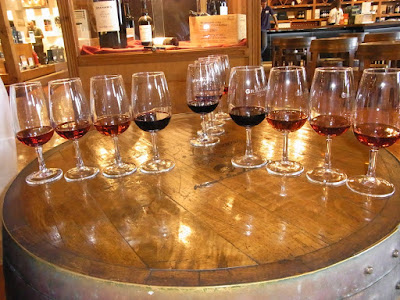Port is made in a completely different manner than other wines. To understand the difference it’s important to understand the wine’s historical origin. Port wine originated in the Douro Valley which lies in Portugal’s northeast corner near the Spanish border. The Romans, who invaded Portugal before the birth of Christ, brought with them a depth of wine-making knowledge. They pain-stakingingly constructed stone terraces which allowed vineyards to be built and worked on the Douro Valley's inhospitably steep hillsides.
This 17th century map shows the many countries to where Port was shipped from PortoPort wine received its name from the city in Portugal from which it was first shipped, Porto. Barrels of wine were transported by small boats from the wineries of the Douro Valley down river to Porto. Located where the mouth of the Douro River meets the Atlantic Ocean, Porto played an important role in exporting Port to the remainder of Europe and the world. This leads to Port’s biggest difference from other wine. Let me explain.
Port wine was taken from Douro Valley downstream to Porto on the Douro RiverPort is a “fortified” wine which means that alcohol (e.g. a spirit such as brandy) has been added. In learning about Port, it’s important to understand why this alcohol was originally added. During the 17th century, England (a country of French wine lovers), had levied a huge tax on French wines. It didn’t take long for British wine importers to look for alternate sources. Voila! The first wines shipped by boat from Porto arrived in England spoiled. Someone had the genius idea of adding Brandy to the wine to preserve it during its long maritime journey. The Brits loved this new high-octane edition of Portuguese red wine and Port was born. The rest is history.
Today, alcohol is added to Port half-way during the fermentation of grapes in the Douro Valley. The alcohol actually stops fermentation. During fermentation sugar is converted into alcohol. Stopping fermentation midway means there is still sugar remaining in the wine. This is why Port is sweeter (100 grams per liter of sugar) than regular wine (dry wine has <1 gram per liter). Since a brandy type alcohol is added, Port is also higher in alcohol (20%) than table wine (12-14%).
Port can be a mixture of different grapes as well as wine from different yearsThe second significant difference is that Port is a blended wine. While other wines are often blends of different grape varieties, Port is not only a mixture of many diverse grapes from many different vineyards, but also is a blending of several different vintages of the same wine.
Wine-Knows will taste a lineup of several Ports in Porto & the Douro Valley
Thirdly, Port is also unique in that it is made in several styles. These different types of Port are based on the quality of the grapes, as well as how long it has been aged. Here are some examples of the most well-known styles:
- Ruby is the least expensive and less complex Port. It is aged for only 3 years in the bottle. Ruby is often served chilled as an aperitif.
- Tawny is named for its amber color. This Port, aged in barrels for at least 3 years, offers more complexity. Tawny can also be served as an aperitif, or offered at the end of the meal.
- Vintage is only 2% of Port's production. It is made in the best years by only the top estates. Bottle-aged often for
decades, it is known for having explosive aromas and rich, concentrated flavors. Vintage Port's classical pairing is with a blue cheese.
Wine-Knows will be visiting Porto this September and will be tasting Port at two of Portugal’s most famous wineries. But, our Port education won’t end there as we will travel up river to the Douro Valley for two nights. During our stay we'll visit another two wineries and actually see the dramatic steep vineyards that were originally carved out by the Romans nearly 2,000 years ago. The Douro's vineyards are so special that they have been declared a World Heritage Site by the United Nations (UNESCO).





No comments:
Post a Comment